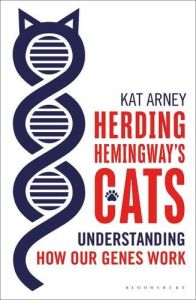Join getAbstract to access the summary!

Join getAbstract to access the summary!
Kat Arney
Herding Hemingway's Cats
Understanding How Our Genes Work
Bloomsbury USA, 2016
What's inside?
This irreverent primer teaches the revolutionary concepts and myths of genetics.
Recommendation
From cats with extra toes to “zombie genes,” science writer and broadcaster Kat Arney delves irreverently into the world of genetics. In short, entertaining chapters, she introduces the leading scientists and deepest questions in this complex field. She never stints on the science, yet the text remains breezy and accessible. Arney highlights amazing discoveries in genetics and details how complex organisms arise from simple strings of “DNA letters.” It’s a rapid-fire, rewarding and, given the subject, sometimes complex read. getAbstract recommends Arney’s iconoclastic account to anyone seeking grounding in one of the most striking, fast-developing areas of science.
Summary
About the Author
Science communicator, writer and musician Kat Arney holds a PhD in developmental biology.
















Comment on this summary